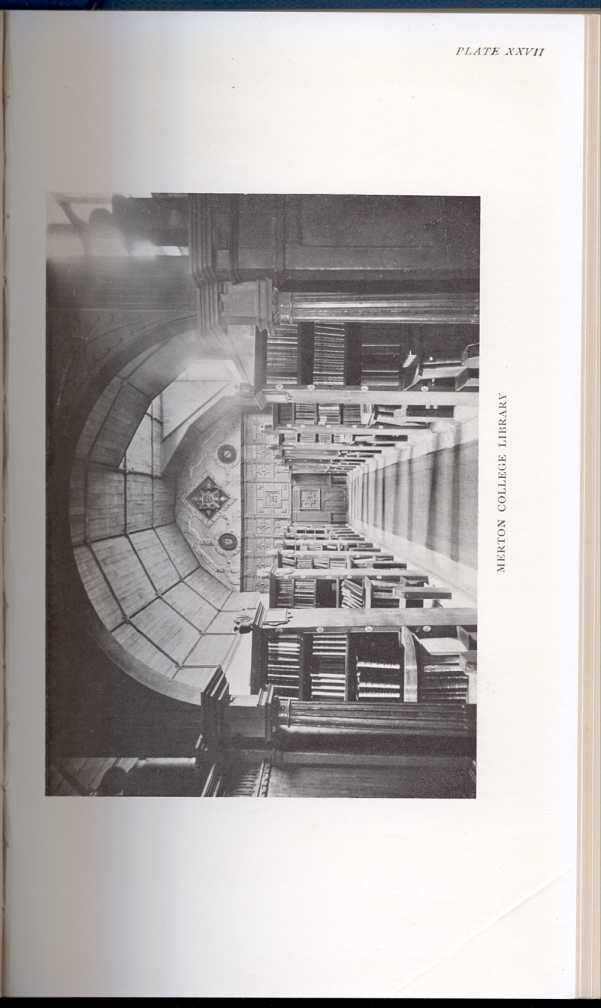3. § III
Towards the end of the fifteenth century the beginning of the sad end
of all this good work may be traced. Some part of the collections
disappeared gradually. In 1458 books were chained at Exeter College,
because some of them had been taken away. When volumes became damaged
and worn out, they were not replaced by others. Some were pledged, and
although every effort was made to redeem them, as at Exeter College in
1466, 1470, 1472 and 1473, yet it seems certain many were permanently
alienated. Others were perhaps sold, or given away, as John Phylypp gave
away two Exeter College manuscripts in 1468.
[6.53] The University library was in similar case.
When Erasmus saw the scanty remains of
this collection he could have wept. "Before it had continued eighty
years in its flourishing state," writes Wood of the library, "[it] was
rifled of its precious treasure! by unreasonable persons. That several
scholars would,, upon small pledges given in, borrow books . . . that
were never restored. Polydore Virgil . . . borrowed many after such a
way; but at length being denied, did upon petition made to the king
obtain his license for the taking out of any MS. for his use (in order,
I suppose, for the collecting materials for his English History or
Chronicle of England), which being imitated by others, the library
thereby suffered very great loss." Matters became still worse. Owing to
the threatened suppression of the religious houses, the number of
students at Oxford decreased enormously. In 1535, 108 men graduated, in
the next year only 44 did so; until the end of Henry VIII's reign the
average number graduating was 57, and in Edward's reign the average was
33.
[6.54] Naturally, therefore, some laxity
crept into the administration of the University and the colleges. Active
enemies of our literary treasures were not behindhand, In 1535 Dr.
Layton, visitor of monasteries, descended upon Oxford. "We have sett
Dunce [Duns Scotus] in Bocardo, and have utterly banisshede hym Oxforde
for ever, with all his blinde glosses, and is nowe made a comon servant
to evere man, faste nailede up upon posses in all comon howses of
easment: id quod oculis meis vidi. And the seconde tyme we came to New
Colege, affter we trade declarede your injunctions, we fownde all the
gret quadrant court full of the leiffes of Dunce, the wynde blowyng them
into evere corner. And ther we fownde one Mr. Grenefelde, a gentilman of
Bukynghamshire, getheryng up part of the saide bowke leiffes (as he
saide) therwith to make hym sewelles or blawnsherres to kepe the
dere within the woode, therby to have the better cry with his
howndes."
[6.55] A commission assembled at
Oxford in 1550, and met many times at St. Mary's Church. No documentary
evidence of their treatment of libraries remains, but it was certainly
most drastic. Any illuminated manuscript, or even a mathematical
treatise illustrated with diagrams, was deemed unfit to survive, and was
thrown out for sale or destruction. Some of the college libraries did
not suffer severely. Most of Grey's books survived in Balliol, although
the miniatures were cut out. Queen's, All Souls, and Merton came
through the ordeal nearly unscathed. But Lincoln lost the books given
by Gascoigne and the Italian importations of Flemming; Exeter College
was purged. The University library itself was entirely dispersed. One of
the commissioners, "by name Richard Coxe, Dean of Christ Church, shewed
himself so zealous in purging this place of its rarities . . . that . .
. savoured of superstition, that he left not one of those goodly MSS.
given by the before mentioned benefactors. Of all which there were none
restored in Q. Mary's reign, when then an inquisition was made after
them, but only one of the parts of Valerius Maximus, illustrated with
the Commentaries of Dionysius de Burgo, an Augustine Fryer, and with the
Tables of John Whethamsteed, Abbat of St. Alban's. That some of the
books so taken out by the Reformers were burnt, some sold away for Robin
Hood's pennyworths,
[6.56] either to
Booksellers, or to Glovers, to press their gloves, or Taylors to make
measures, or to bookbinders to cover books bound by them, and some also
kept by the Reformers for their own use. That the said library being
thus deprived of its furniture was employed, as the schools were, for
infamous uses. That in laying waste in that manner, and not in a
possibility (as the academians
thought) of restoring it to its former estate, they ordered certain
persons in a Convocation (Reg. 1. fol. 157
a)
held Jan. 25, 1555-56 to sell the benches and desks "herein; so that
being strips stark naked (as I may say) continued so till Bodley
restored it."
[6.57] The only cheerful
reference to this period is that by Wood, who tells us some friendly
people bought in a number of the manuscripts, and ultimately handed them
over to the University after the library's restoration.
[6.58] But of all the books given by the Duke of
Gloucester only three are now in the Bodleian, and only three others in
Corpus Christi, Oriel, and Magdalen. The British Museum possesses nine;
Cambridge one; private collectors two. Six are in France: two
Latin—both Oxford books—and three French manuscripts in the
Bibliothèque Nationale, and one manuscript at the
Bibliothèque Ste. Genevieve. The Ste. Genevieve book
[6.59] is a magnificent Livy, once belonging to
the famous Louvre Library. It bears the inscription: "Cest livre est a
moy Homfrey, duc de Gloucestre, du don mon tres chier cousin le conte de
Warewic."
[6.60]
 [Description: MERTON COLLEGE LIBRARY]
[Description: MERTON COLLEGE LIBRARY]